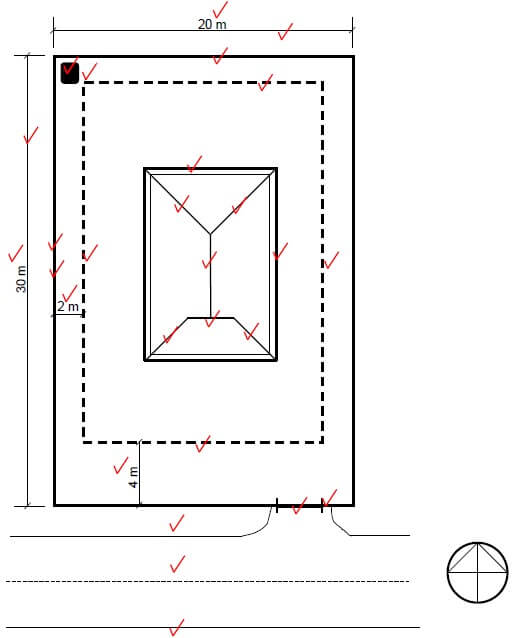CIVIL TECHNOLOGY PAPER GRADE 12 MEMORANDUM - NSC PAST PAPERS AND MEMOS SEPTEMBER 2016
Share via Whatsapp Join our WhatsApp Group Join our Telegram GroupCIVIL TECHNOLOGY PAPER
GRADE 12
NSC PAST PAPERS AND MEMOS
SEPTEMBER 2016
MEMORANDUM
QUESTION 1: CONSTRUCTION PROCESSES
1.1
1.1.1 Raking shore √ (1)
1.1.2
1.1.A – Shoring planks / board / steel panel √
1.1.B – Raking shore √
1.1.C – Sole plate √ (3)
1.2 Name the following tools an name ONE use of each:
1.2.1 - Claw hammer
Any ONE use:
- Hammering in nails √√
- Claws are used to pull out nails √√ (Any 1 x 2) (2)
1.2.2 - Sliding bevel
Any ONE use:
- Marking lines at any angle √√
- Test angles √√ (Any 1 x 2) (2)
1.2.3 - Short jointer
Any ONE use:
- Finishing vertical mortar joints √√ (2)
1.2.4 - Bricklaying pins and lines
Any ONE use:
- Setting building lines √√ (2)
1.2.5 - Portable jig saw
Any ONE use:
- Cutting of curves √√
- Cutting straight cuts √√ (Any 1 x 2) (2)
1.3 (1) The turning blade can (2) cause damage / injuries to the subject it is placed on. (2)
1.4 FIGURE 1.4 shows the brickwork for an outer wall.
1.4.1 Cavity wall (1)
1.4.2 Any THREE advantages of this type of wall construction.
- Prevent damp to penetrate to the inner wall. √
- Good thermal isolation √
- No rendering / plastering required for outer walls √
- Inner walls can be built with cheaper bricks √
- Good sound isolation √ (Any 3 x 1) (3)
1.4.3 (1) So that damp / water that penetrate the wall, (2) can be discharged. (2)
1.5 FIGURE 1.5 shows the uncompleted fixing of a roof truss on a wall. Answer the following questions with regard to the construction in FIGURE 1.5. 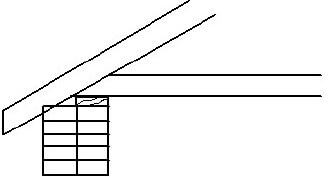
1.5.1
1.5.A – Rafter √
1.5.B – Tie beam √
1.5.C – Wall plate √ (3)
1.5.2 (1) Distribute the load (2) of the truss to the wall. (2)
1.5.4 Any similar answer:
(1) Wall plate
(2) pressure on the
(3) bending part of the tie beam.
OR
(2) Wall plate
(2) pressure on
(3) intersection / corner of rafter and tie beam.
OR 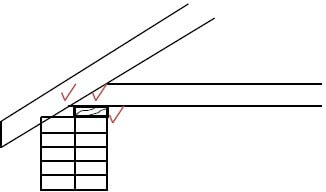 (3)
(3)
[30]
QUESTION 2: ADVANCED CONSTRUCTION PROCESSES
2.1 (1) Carry loads / brick work (2) over openings / windows / doors. (2)
2.2
- Soda √
- Silica √
- Chalk √ (3 x 1) (3)
2.3 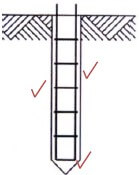 (3)
(3)
2.4 (Any similar description.)
- Soil below offers
- better stability / hardness / firmness. (2)
2.5 Any FOUR factors which will have an influence in the choice of the correct type of foundation:
- Load bearing ability of the ground √
- Depth at which load bearing ground can be found √
- Level of water table √
- Distance from trees and other structures √
- Weight of the building √ (Any 4 x 1) (4)
2.6 (1) Prevents the damp proofing (2) from being punctured by (3) the hardcore filling. (3)
2.7
2.7.1 THREE requirements to which steel reinforcement must comply.
- Resist tensile stress. √√
- Easily be bent into the required shape. √√
- The surface must bond with the concrete. √√ (3 x 1) (3)
2.7.1
- Gloves
- Overalls
- Safety shoes
- Hard hat
- Safety glasses (Any 3 x 1) (3)
2.8
2.8.1 FALSE (1)
2.8.2 FALSE (1)
2.8.3 FALSE (1)
2.8.4 FALSE (1)
2.8.5 TRUE (1)
2.8.6 TRUE (1)
2.8.7 TRUE (1)
2.8.8 TRUE (1)
2.9
2.8.1 Flat arch √ (1)
2.8.2 (Similar answer) (1) Prevents illusion (2) that the arch is bent downwards. (2)
2.8.3
2.8.A – Voussoirs √
2.8.B – Abutment √ (2)
2.9 (1) Bind different (2) steel parts together. (2)
2.10 2.10.1 300 mm √ (1) 2.10.2 600 mm √ (1)
[40]
QUESTION 3: CIVIL SERVICES
3.1
3.1.1 Water service point √ (1)
3.1.2
3.1.B – Stop cock √
3.1.C – Water meter √
3.1.D – Municipal water supply / Reticulating piping √
3.1.E – User / consumer pipe √ (4)
3.1.3 Ø20 mm √ (1)
3.1.4 Local authority / Municipality √ (1)
3.2 (1) Catch water when (2) geyser is leaking / serviced / water not damaging the ceiling. (2)
3.3 (Any similar answer.) (1) Receiving most sun rays (2) from northern side. (2) 3.4 3.4.1 Ball valve √ (1)
3.4.1 Any TWO positions
- Geyser √
- Water storage tank of water closet (toilet) √ (2 x 1) (2)
3.5
3.5.1 UNDERGROUND √ (1)
3.5.2 TWO √ (1)
3.5.3 SETTLE DOWN √ (1)
3.5.4 ANAEROBIC BACTERIA √ (1)
3.6 Test if drain pipe is clear of obstructions. √ (1)
3.7 600 mm √ (1)
3.8 Any THREE positions in a drain system where access openings must be installed.
- Drain change in direction √
- Junction with other drain pipes √
- Every 45 m in system √
- Beginning of drain √
- Drain gradient change √ (3 x 1) (3)
3.9  (4)
(4)
3.10 Cleaning rods √ (1)
3.11 Any TWO advantages of wind turbines for electricity supply.
- Clean fuel √
- No pollution √
- Renewable √ (2 x 1) (2)
[30]
QUESTION 4: MATERIALS AND QUANTITIES
4.1 Any THREE properties of coal tar creosote for wood preservation.
- Outdoor use √
- Use for wood that is in contact with the ground √
- Resistant to maceration √
- Dark colour √
- Discolours the timber √
- Cannot be painted √
- Does not affect the dimensions √
- Strong odour √ (Any 3 x 1) (3)
4.2
1.6.1 Natural / air seasoning √ (1)
1.6.2 (1) Ensure proper air circulation and (2) not absorb moisture from the ground. (2)
1.6.3 Any TWO requirement of the foundation for this seasoning method.
- Sturdy √
- Treated poles / Concrete / bricks √
- Even √ (Any 2 x 1) (2)
4.3 Any FOUR advantages of PVC for the use drain pipes.
- Light in weight √
- Long lengths available √
- Less jointing √
- Tight joints √
- Handle / install easy √
- Good flow efficiency √
- Resistance to chemicals / sewer √ (Any 4 x 1) (4)
4.4 (1) Odd number of (2) layers of veneer (3) with the grain glued at right angles. (3)
4.5
4.5.1 FALSE (1)
4.5.2 FALSE (1)
4.5.3 TRUE (1)
4.5.4 FALSE (1)
4.5.5 TRUE (1)
4.6 FIGURE 4.6 shows the foundation strips for a building. The foundations are 700 mm wide and 200 mm thick and a concrete mix of 1 : 3 : 4 is used. The centre line measurement of the building is 31,6 m and the total volume concrete needed for the foundation is 4,424 m³. Determine the following quantities for the concrete mix:
4.6.1 Volume sand needed.
4,424 m³ x 3/8 = 1,659 m³ (3)√√√
4.6.2 Volume stone needed.
4,424 m³ x 4/8 = 2,212 m³ (3) √√√
4.6.3 Calculate the number bags of cement needed if the content of a bag cement is 0,033 m³.
4,424 m³ x 1/8 = 0,553m³/0,033 = 16,75 = 17 bags cement (4)√√√√
[30]
QUESTION 5: APPLIED MECHANICS
5.1 Calculate the centroid of the body in FIGURE 5.1 from point P.
X = b/3 = 3/3 = 1 √
= 3 – 1 + 1 = 3 √
Y = h/3 = 6/3 = 2 √
= 2 + 2 = 4 √(4)
5.2 FIGURE 5.2, on ANSWER SHEET A, shows the space diagram for a roof truss. Determine graphically, on ANSWER SHEET A by drawing the force diagram and completing the table, the size and nature of the forces in the parts of the truss. (18) 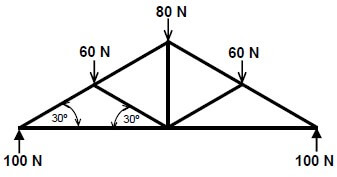
5.3 FIGURE 5.3 shows a beam with point loads. Calculate the reaction forces of the supports A and B. 
Around A Around B
M.L M.R
(B x 6)+(20 x 2) = (25 x 4)+(30 x 6) (A x 6) = (25 x 2) + (40 x 6) + (20 x 8)
B6 + 40 = 100 + 180 A6 = 50 + 240 + 160
B6 = 280 – 40 A6 = 450
B = 240/6 A = 450/6
= 40 N = 75 N (8)
[30]
QUESTION 6: GRAPHICS AND COMMUNICATION
6.1 FIGURE 6.1 on ANSWER SHEET B shows the outer lines of a structure which must be built on a site. Draw the site plan on scale 1 : 200 on ANSWER SHEET B so that the structure is in the middle of the site. The site plan must comply too the following requirements:
6.1.1 Site size is (1) 20 m wide from east to west and (2) 30 m long from south to north (2)
6.1.2 Pavement of (1) 2 m and the street of (2) 6 m at the (3) south side (4)
6.1.3 Building boundaries are (1) 2 m at the (2) east, north and west sides and (3) 4 m at the south side (4)
6.1.4 (1) 3 m Wide entrance to (2) the site (2)
6.1.5 (1) Datum level in the (2) north-western corner of the site (2)
Draw also the roof plan on the structure and indicate the following:
6.1.6 Overhang of 400 mm (2)
6.1.7 Hipped end at the north end (2)
6.1.8 American cable end at the south end (3)
6.1.9 Ridge (1)
Indicate the following measurements:
6.1.10 Length and width of the site (4)
6.1.11 Southern and western building boundaries (2)
6.2 Sketches to illustrate the following symbols on a floor plan:
6.2.1 Water meter (2)
6.2.2 Vent pipe ![]() (2)
(2)
6.2.3 Bath (2)
6.2.4 Water closet (2)
6.2.5 Sink (2)
6.2.6 Power point (2)
[40]
TOTAL: 200
ANSWER SHEETA | CIVIL TECHNOLOGY | NAME: |
QUESTION 5.2 (18) 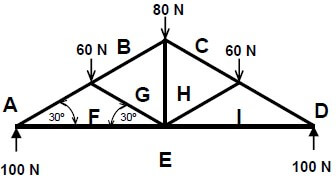
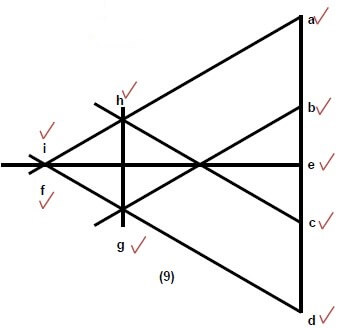
SPACE DIAGRAM:
SCALE: 2 mm = 1 N
| PART | STRUT ↔ | TIE |
| AF | 100N | |
| BG | 70N | |
| CH | 70N | |
| DI | 100N | |
| EI | 85N | |
| EF | 85N | |
| FG | 30N | |
| GH | 30N | |
| HI | 30N |
ANSWER SHEETB | CIVIL TECHNOLOGY | NAME: |
QUESTION 6.1 (28)